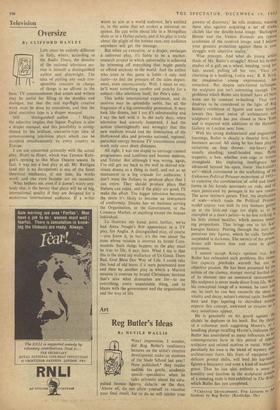Art
Reg Butler's Ideas
By NE VILE WALLIS
SPECTAT OR. DECEMBER 1 4 , 1962 powers of discovery,' he tells students, warning them also against acquiring a set of trick% clichés like the double-head image. 'Burlington House and the Venice Biennale are typical academies of the received image, and I believe your greatest protection against these is your struggle with objective reality.' Wise precepts. And what do young artists think of Mr. Butler's struggle? About his bronze studies of a girl, on a wheel, bending, tying her hair, seated, pulling off her vest, 'They are charming in a budding. Lolita way,' R. B. KitA the imaginative • young expressionist, has remarked. But despite sure-footed technique, the sculpture just isn't interesting enough. The problems which Butler sets himself have all been worn out by constant re-hashing: That viol deserves to be considered in the light of Reg Butler's exhibition of figures and some bronze towers (his latest union of architecture and sculpture) which has just closed in New York and is expected with additions at the Hanover Gallery in London next June.
With his strong architectural and engineering
learnings, Butler is clearly a theorist first. and humanist second. All along he has been playing variations on four themes: top-heavy girl' usually standing; small-headed man; flying trapezist; a box, whether iron cage or bronze stronghold. His exploring intelligence has advanced beyond his open, linear'
blacksmith's
arr—which culminated in the scaffolding of his Unknown Political Prisoner monument of l953-- to conceive the combination of solid and lineal. forms in his female aeronauts on rods, and oi mass penetrated by passages in his new towers' The same instincts persist. First, the implication of scale—which made the Political Prisoner model appear vast with its tiny humans gazit).1 up at the look-out cage (so slight as to he crumpled in a man's palm)—is no less striking in his little slotted bastilles, which assume tower- ing proportions. That brings one to his Kai" kaesque fantasy. Peering through the slots one, perceives tiny figures, which he calls 'fetishes' suspended in darkness. The secrecy of the prison' house still haunts him and must be given expression. I cannot accept Kitais opinion that Reg Butler has exhausted such problems. His inven' tive capacity precludes warmth but not alj objective passion. He has been possessed by the, notion of the clumsy, stumpy mortal hurtled oul of its element into an unnatural environmelt His sculpture is never made direct from life. Will; his conceptual image of a woman, he once WI', me, he feels he can best reconcile the ideas 0"- vitality and decay, nature's eternal cycle. Swelling bust and hips tapering to shrivelled stuniP.51 express this concept, awkward or evasive as may sometimes appear. He is genuinely on his guard against the clichés he deplores in his book. But the thrusl of a columnar neck suggesting Moore's, or headlong plunge recalling Marini's, -indicates tb Butler has assimilated as many influences as Pi contemporaries have in this period of inbreu, sculpture and related motives in metal. What It5 1 peculiarly his own is the blend of mystery Wtt architectonic form. His feats of equipoise. in` delicate pivotal shifts, will lend his top-heavY, figures a buoyancy and even a kind of audaciotl', grace. That he can also embody a sense humility and fatalism in the sculptural tension of a standing nude is best exhibited in The Bride' which Butler has just completed.
* CREATIVE DEVELOPMENT. Five Lectures to Art Students by Reg Butler. (Routledge, 10s.)


































 Previous page
Previous page